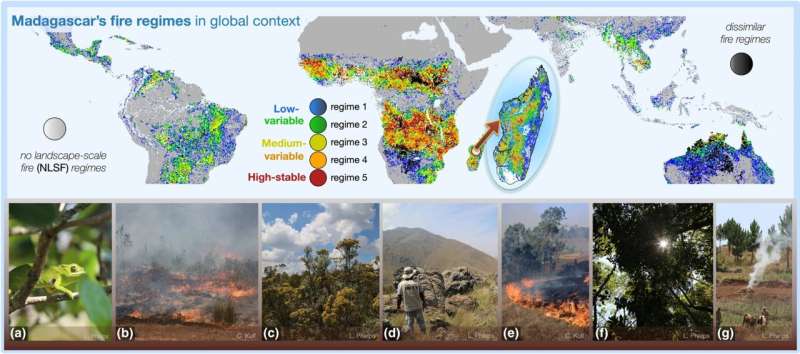Once humans discovered how to tame fire, they began using it for heat and cooking as well as to scare away animals and to alter their environs, especially burning areas to plant and to restore grazing land. In Madagascar, scientists and conservationists have long believed that fire is a leading cause of high landscape degradation, but an international team of researchers have found that medium to large fires on the island are similar to other tropical locations.
“On Madagascar, it is assumed that fire is driving degradation,” said Leanne Phelps, postdoctoral fellow in anthropology at Penn State, School of GeoSciences, University of Edinburgh and Royal Botanic Gardens, Edinburgh. “We are taking a new comparative approach and asking: Is fire different on Madagascar? And is it responsible for high rates of landscape degradations?”
The researchers report today (May 18) in Global Change Biology that Madagascar’s fire regimes are similar to 88% of tropical burned areas with shared climate and vegetation characteristics. They also found that Madagascar’s relatively high tree losses where not centered around boundaries between forest and savannah, but occurred internally in forests without landscape-scale fires, suggesting medium to large fires did not cause high rates of tree loss.
Landscape-size fires are anything over about 50 acres. In Madagascar they are used on grass lands to improve grazing for cattle. However, the researchers found that “fire is declining across tropical grassy ecosystems with major implications for ecosystems livelihoods and the future of fire risk.”
“We found that rather than Madagascar being an exception, it is a microcosm of global patterns,” said Kristina Douglass, Joyce and Doug Sherwin Early Career Professor in the Rock Ethics Institute and Assistant Professor of Anthropology and African Studies, Penn State. “Despite what people think, fire is declining in grassy areas in general and it is declining faster on Madagascar. It is not the primary driver of tree loss. Fire is not a uniform proxy for degradation.”
The assumption is usually if people are there and large areas are burning, that is causing high landscape degradation.
“We need to use more evidence-based approaches to understand why landscapes change,” said Phelps. “Mitigating climate change and managing biodiversity become difficult when we aren’t looking closely enough at the causes of problems.”
The researchers believe that more research is necessary to determine where fire poses the highest risks and where it is actually needed to ensure that savannahs and forests thrive, and that invasive species do not invade.
You may like to read:


